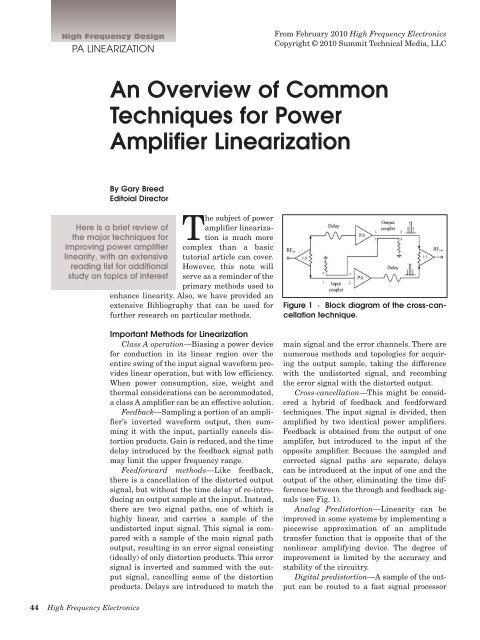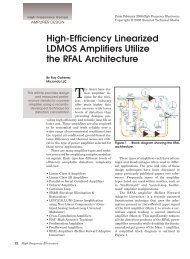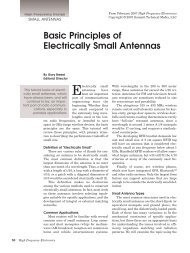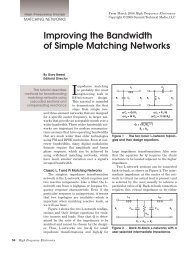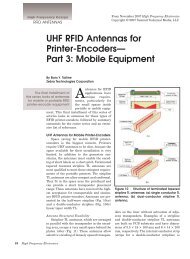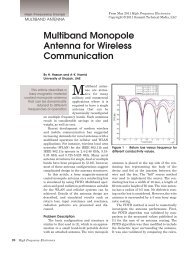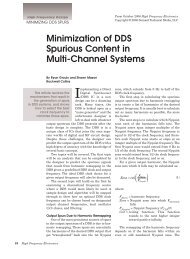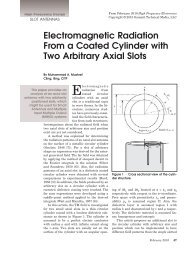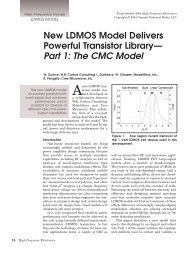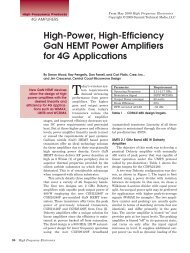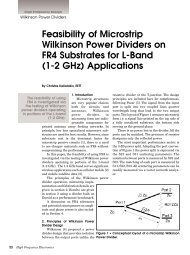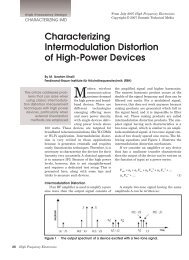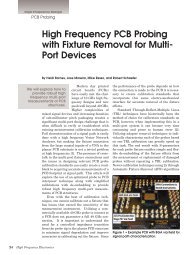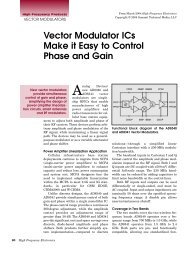An Overview of Common Techniques for Power Amplifier Linearization
An Overview of Common Techniques for Power Amplifier Linearization
An Overview of Common Techniques for Power Amplifier Linearization
You also want an ePaper? Increase the reach of your titles
YUMPU automatically turns print PDFs into web optimized ePapers that Google loves.
High Frequency Design<br />
PA LINEARIZATION<br />
From February 2010 High Frequency Electronics<br />
Copyright © 2010 Summit Technical Media, LLC<br />
<strong>An</strong> <strong>Overview</strong> <strong>of</strong> <strong>Common</strong><br />
<strong>Techniques</strong> <strong>for</strong> <strong>Power</strong><br />
<strong>Amplifier</strong> <strong>Linearization</strong><br />
By Gary Breed<br />
Editoial Director<br />
The subject <strong>of</strong> power<br />
Here is a brief review <strong>of</strong> amplifier linearization<br />
is much more<br />
the major techniques <strong>for</strong><br />
improving power amplifier complex than a basic<br />
linearity, with an extensive tutorial article can cover.<br />
reading list <strong>for</strong> additional However, this note will<br />
study on topics <strong>of</strong> interest serve as a reminder <strong>of</strong> the<br />
primary methods used to<br />
enhance linearity. Also, we have provided an<br />
extensive Bibliography that can be used <strong>for</strong><br />
further research on particular methods.<br />
Important Methods <strong>for</strong> <strong>Linearization</strong><br />
Class A operation—Biasing a power device<br />
<strong>for</strong> conduction in its linear region over the<br />
entire swing <strong>of</strong> the input signal wave<strong>for</strong>m provides<br />
linear operation, but with low efficiency.<br />
When power consumption, size, weight and<br />
thermal considerations can be accommodated,<br />
a class A amplifier can be an effective solution.<br />
Feedback—Sampling a portion <strong>of</strong> an amplifier’s<br />
inverted wave<strong>for</strong>m output, then summing<br />
it with the input, partially cancels distortion<br />
products. Gain is reduced, and the time<br />
delay introduced by the feedback signal path<br />
may limit the upper frequency range.<br />
Feed<strong>for</strong>ward methods—Like feedback,<br />
there is a cancellation <strong>of</strong> the distorted output<br />
signal, but without the time delay <strong>of</strong> re-introducing<br />
an output sample at the input. Instead,<br />
there are two signal paths, one <strong>of</strong> which is<br />
highly linear, and carries a sample <strong>of</strong> the<br />
undistorted input signal. This signal is compared<br />
with a sample <strong>of</strong> the main signal path<br />
output, resulting in an error signal consisting<br />
(ideally) <strong>of</strong> only distortion products. This error<br />
signal is inverted and summed with the output<br />
signal, cancelling some <strong>of</strong> the distortion<br />
products. Delays are introduced to match the<br />
Figure 1 · Block diagram <strong>of</strong> the cross-cancellation<br />
technique.<br />
main signal and the error channels. There are<br />
numerous methods and topologies <strong>for</strong> acquiring<br />
the output sample, taking the difference<br />
with the undistorted signal, and recombing<br />
the error signal with the distorted output.<br />
Cross-cancellation—This might be considered<br />
a hybrid <strong>of</strong> feedback and feed<strong>for</strong>ward<br />
techniques. The input signal is divided, then<br />
amplified by two identical power amplifiers.<br />
Feedback is obtained from the output <strong>of</strong> one<br />
amplifer, but introduced to the input <strong>of</strong> the<br />
opposite amplifier. Because the sampled and<br />
corrected signal paths are separate, delays<br />
can be introduced at the input <strong>of</strong> one and the<br />
output <strong>of</strong> the other, eliminating the time difference<br />
between the through and feedback signals<br />
(see Fig. 1).<br />
<strong>An</strong>alog Predistortion—Linearity can be<br />
improved in some systems by implementing a<br />
piecewise approximation <strong>of</strong> an amplitude<br />
transfer function that is opposite that <strong>of</strong> the<br />
nonlinear amplifying device. The degree <strong>of</strong><br />
improvement is limited by the accuracy and<br />
stability <strong>of</strong> the circuitry.<br />
Digital predistortion—A sample <strong>of</strong> the output<br />
can be routed to a fast signal processor<br />
44 High Frequency Electronics
High Frequency Design<br />
PA LINEARIZATION<br />
that calculates the necessary correction to the transfer<br />
function. Speed must be sufficient to update the correction<br />
as operating parameters change due to thermal<br />
effects, aging, duty cycle and output power level. This<br />
method is being extensively used, and steadily improved,<br />
in current wireless systems.<br />
Linearity by design—There are also amplifier circuits<br />
such as the Doherty method, outphasing, and combined<br />
polar/amplitude modulation that have greater inherent<br />
linearity, at the cost <strong>of</strong> increased complexity. These are<br />
not linearization techniques per se, but do result in an<br />
amplifier with greater linearity than traditional designs.<br />
Bibliography—Textbooks<br />
S. Cripps, RF <strong>Power</strong> <strong>Amplifier</strong>s <strong>for</strong> Wireless<br />
Communications, 2nd ed., Artech House, 2006.<br />
P. B. Kenington, High Linearity RF <strong>Amplifier</strong> Design,<br />
Boston: Artech House, 2000.<br />
J.L.B. Walker, High-power GaAs FET <strong>Amplifier</strong>s,<br />
Artech House, 1999.<br />
N. Pothecary, Feed<strong>for</strong>ward Linear <strong>Power</strong> <strong>Amplifier</strong>s,<br />
Artech House, 1999.<br />
Papers and Articles<br />
R. Gutierrez, “The RFAL Technique <strong>for</strong> Cancellation <strong>of</strong><br />
Distortion in <strong>Power</strong> <strong>Amplifier</strong>s,” High Frequency<br />
Electronics, vol. 4, pp. 18-28, June 2004.<br />
R. Guutierrez, “High-Efficiency Linearized LDMOS<br />
<strong>Amplifier</strong>s Utilize the RFAL Architecture,” High<br />
Frequency Electronics, Feb. 2006.<br />
R. Gupta, S. Ahmad, R. Ludwig, J. McNeill, “Adaptive<br />
Digital Baseband Predistortion <strong>for</strong> RF <strong>Power</strong> <strong>Amplifier</strong><br />
<strong>Linearization</strong>,” High Frequency Electronics, Sep. 2006.<br />
B. Lee, L. Dunleavy, “Understanding Base Biasing<br />
Influence on the Large Signal Behavior in HBTs,” High<br />
Frequency Electronics, May 2007.<br />
S. Wood, R. Pengelly, J. Crescenzi, “A High Efficiency<br />
Doherty <strong>Amplifier</strong> with Digital Predistortion <strong>for</strong> WiMAX,”<br />
High Frequency Electronics, Dec. 2008.<br />
T. Nelson, “Intergrated Receiver Simplifies the <strong>An</strong>alog<br />
Side <strong>of</strong> Digital Predistortion, High Frequency Electronics,<br />
July 2009.<br />
A. Grebennikov, “Linearity Improvement <strong>Techniques</strong><br />
<strong>for</strong> Wireless Transmitters: Part 1,” High Frequency<br />
Electronics, May 2009.<br />
A. Grebennikov, “Linearity Improvement <strong>Techniques</strong><br />
<strong>for</strong> Wireless Transmitters: Part 2,” High Frequency<br />
Electronics, June 2009.<br />
S. Wood, R. Pengelly, D. Farrell, C. Platis, J. Crescenzi,<br />
“High-<strong>Power</strong>, High Efficiency GaN HEMT <strong>Power</strong><br />
<strong>Amplifier</strong>s <strong>for</strong> 4G Applications,” High Frequency<br />
Electronics, May 2009.<br />
H. Choi, Y. Jeong, J. S. Kenney, and C. D. Kim, “Cross<br />
Cancellation Technique Employing an Error <strong>Amplifier</strong>,”<br />
IEEE Microwave and Wireless Comp. Lett., vol. 18, July<br />
2008.<br />
M. Nakayama, K. Mori, K. Yamauchi, Y. Itoh, and Y.<br />
Mitsui, “<strong>An</strong> Amplitude and Phase Linearizing Technique<br />
<strong>for</strong> Linear <strong>Power</strong> <strong>Amplifier</strong>s,” Microwave Journal, vol. 39,<br />
Mar. 1996.<br />
J. Yi, Y. Yang, M. Park, W. Kang, and B. Kim, “<strong>An</strong>alog<br />
Predistortion Linearizer <strong>for</strong> High-<strong>Power</strong> RF <strong>Amplifier</strong>s,”<br />
IEEE Trans. Microwave Theory Tech., vol. 48, Dec. 2000.<br />
I. Kim, J. Cha, S. Hong, Y. Y. Woo, J. Kim and B. Kim,<br />
“Predistortion <strong>Power</strong> <strong>Amplifier</strong> <strong>for</strong> Base-Station Using a<br />
Feed<strong>for</strong>ward Loop Linearizer,” Proc. 36th Europ.<br />
Microwave Conf., 2006.<br />
A. R. Mansell and A. Bateman, “Adaptive Predistortion<br />
with Reduced Feedback Complexity,” Electronics Letters,<br />
vol. 32, June 1996.<br />
H. S. Black, “Stabilized Feed-Back <strong>Amplifier</strong>s,” Proc.<br />
IEEE, vol. 87, Feb. 1999: reprinted from Electronic<br />
Engineering, vol. 53, Jan. 1934.<br />
H. S. Black, “Inventing the Negative Feedback<br />
<strong>Amplifier</strong>,” IEEE Spectrum, vol. 14, Dec. 1977.<br />
H. A. Rosen and A. T. Owens, “<strong>Power</strong> <strong>Amplifier</strong><br />
Linearity Studies <strong>for</strong> SSB Transmissions,” IEEE Trans.<br />
Commun. Syst., vol. CS-12, June 1964.<br />
C.-C. Hsieh and E. Strid, “A S-Band High <strong>Power</strong><br />
Feedback <strong>Amplifier</strong>,” 1977 IEEE MTT-S Int. Microwave<br />
Symp. Dig.<br />
S. Narayanan, “Application <strong>of</strong> Volterra Series to<br />
Intermodulation Distortion <strong>An</strong>alysis <strong>of</strong> Transistor<br />
Feedback <strong>Amplifier</strong>s,” IEEE Trans. Circuit Theory, vol.<br />
CT-17, Nov. 1970.<br />
Y. Kim, Y. Yang, S. Kang, and B. Kim, “<strong>Linearization</strong> <strong>of</strong><br />
1.85 GHz <strong>Amplifier</strong> Using Feedback Predistortion Loop,”<br />
1998 IEEE MTT-S Int. Microwave Symp. Dig.<br />
Y. Y. Woo, J. Kim, J. Yi, S. Hong, I. Kim, J. Moon, and B.<br />
Kim, “Adaptive Digital Feedback Predistortion Technique<br />
<strong>for</strong> Linearizing <strong>Power</strong> <strong>Amplifier</strong>s,” IEEE Trans.<br />
Microwave Theory Tech., vol. MTT-55, May 2007.<br />
T. Arthanayake and H. B. Wood, “Linear Amplification<br />
Using Envelope Feedback,” Electronics Lett., vol. 7, Apr.<br />
1971.<br />
J.-S. Cardinal and F. Ghannouchi, “A New Adaptive<br />
Double Envelope Feedback (ADEF) Linearizer <strong>for</strong> Solid<br />
State <strong>Power</strong> <strong>Amplifier</strong>s,” IEEE Trans. Microwave Theory<br />
Tech., vol. MTT-43, July 1995.<br />
V. Petrovic and W. Gosling, “Polar-Loop Transmitter,”<br />
Electronics Lett., vol. 15, May 1979.<br />
V. Petrovic, “Reduction <strong>of</strong> Spurious Emission from<br />
Radio Transmitters by Means <strong>of</strong> Modulation Feedback,”<br />
Proc. IEE Conf. Radio Spectrum Conservation Techn.,<br />
1983.<br />
M. Johansson and L. Sundstrom, “Linearisation <strong>of</strong> RF<br />
Multicarrier <strong>Amplifier</strong>s Using Cartesian Feedback,”<br />
Electronics Lett., vol. 30, July1994.<br />
46 High Frequency Electronics


